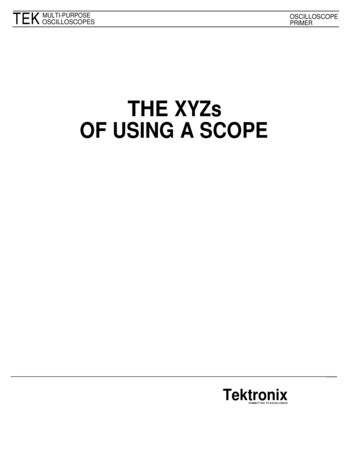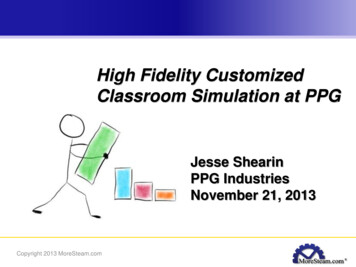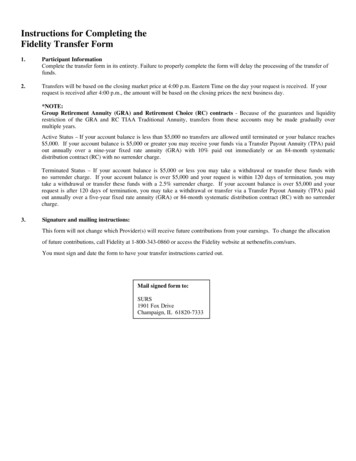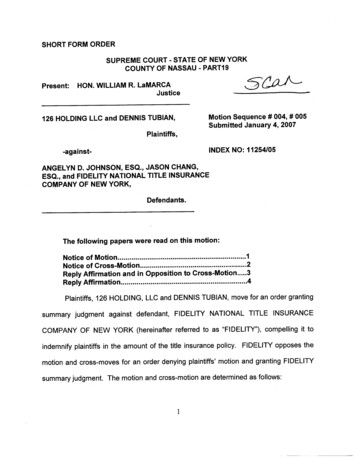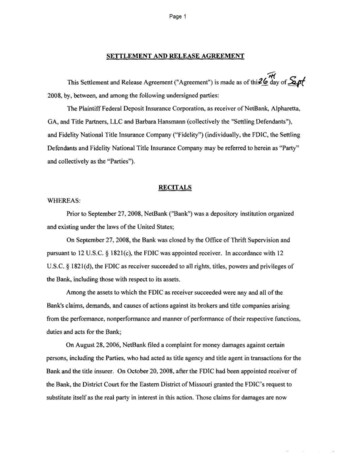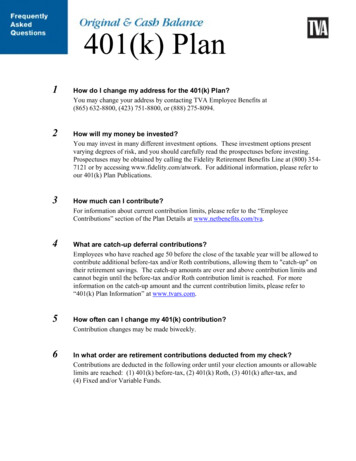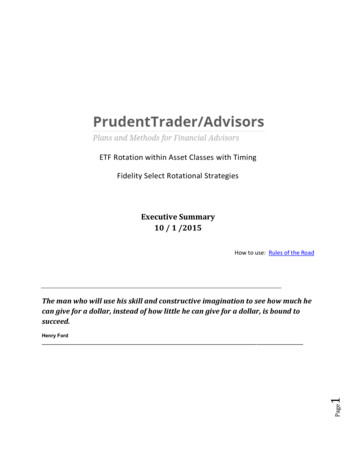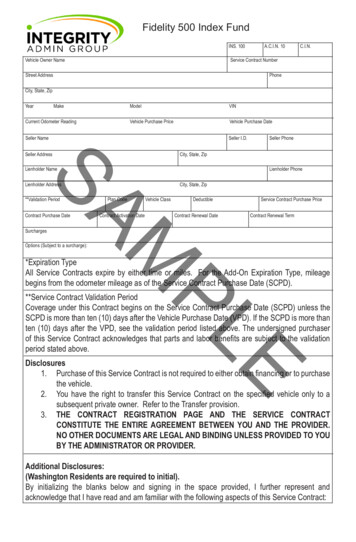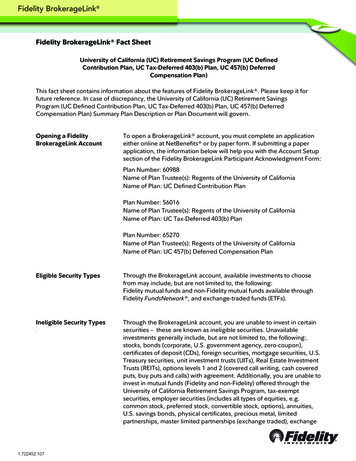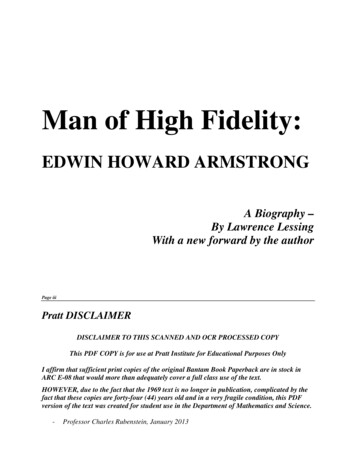
Transcription
Man of High Fidelity:EDWIN HOWARD ARMSTRONGA Biography –By Lawrence LessingWith a new forward by the authorPage iiiPratt DISCLAIMERDISCLAIMER TO THIS SCANNED AND OCR PROCESSED COPYThis PDF COPY is for use at Pratt Institute for Educational Purposes OnlyI affirm that sufficient print copies of the original Bantam Book Paperback are in stock inARC E-08 that would more than adequately cover a full class use of the text.HOWEVER, due to the fact that the 1969 text is no longer in publication, complicated by thefact that these copies are forty-four (44) years old and in a very fragile condition, this PDFversion of the text was created for student use in the Department of Mathematics and Science.-Professor Charles Rubenstein, January 2013
Man of High Fidelity: Edwin Howard ArmstrongEDWIN HOWARD ARMSTRONGWas the last – and perhaps the least known – of the great American Inventors. Without his majorcontributions, the broadcasting industry would not be what it is today, and there would be no FM radio.But in time of mushrooming industry and mammoth corporations, the recognition of individual genius isoften refused, and always minimized.This is the extraordinary true story of the discovery of high fidelity, the brilliant man and his devoted wifewho battled against tremendous odds to have it adopted, and their long fight against the corporations thatchallenged their right to the credit and rewards. Mrs. Armstrong finally ensured that right nearly ten yearsafter her husband’s death.Page iCataloging Information PageThis low-priced Bantam Bookhas been completely reset in a type facedesigned for easy reading, and was printedfrom new plates. It contains the completetext of the original hard-cover edition.NOT ONE WORD HAS BEEN OMITTED.(bantam logo here)MAN OF HIGH FIDELITYA Bantam Book / published by arrangement withJ. B. Lippincott CompanyPRINTING HISTORYLippincott edition published November 1956Bantam edition published Match 1969All rights reserved.Copyright 1956, 1969 by Lawrence Lessing.No part of this book may be reproduced in any form, byMimeograph or other means, without permission.For information address: J. B. Lippincott Company,East Washington Square, Philadelphia, Pennsylvania 10105.Published simultaneously in the United States and CanadaBantam Books are published by Bantam Books, Inc., a subsidiaryof Grosset & Dunlap, Inc. Its trade-mark, consisting of the words“Bantam Books” and the portrayal of a bantam, is registered in theUnited States Patent Office and in other countries. Marca Registrada.Bantam Books, Inc., 271 Madison Avenue, New York, N.Y. 10016.PRINTED IN THE UNITED STATES OF AMERICAPage iv2Revision 1: This document is available electronically /Armstrong.pdf
Man of High Fidelity: Edwin Howard Armstrong(Dedication Page)To YvonnePage vContentsEDWIN HOWARD ARMSTRONG12345678910111213141516Inside CoverPratt PDF DisclaimerCataloging info pageDedicationContentsForewordPreface to First EditionThe Attic InventorA Child in the NinetiesThe Boy Wireless OperatorThe Undergraduate GeniusThe Inventive Act"Feedback" ArmstrongThe Signal Corps MajorThe Superheterodyne FeatThe Progress of Radio - SchematicsYoung Man of the TwentiesArmstrong vs. de ForestThe FM ComebackThe Defender of the Human EarThe Second WarThe Last BattleThe Expense of GreatnessFinal ix4xiii61761014152321342849376445775382-90 271174Page vii3Revision 1: This document is available electronically /Armstrong.pdf
Man of High Fidelity: Edwin Howard ArmstrongForewordOne of the extraordinary but not widely known tales of American invention is the story ofFM or frequency-modulation radio. No major invention of recent times has had a longer, harder,more heroic struggle for existence than this system of high-fidelity broadcasting. Today, somethirty-five years after its conception, FM finally has won legal and historical vindication of suchmagnitude as to lay to rest any doubts as to its authenticity and great worth. This is a fittingoccasion, therefore, for reissuing this life of the inventor, which was first published shortly afterhis despairing death by suicide in 1954, and which is now brought triumphantly up to date.FM was conceived about 1933 by Edwin Howard Armstrong, a noted professor ofengineering at Columbia University and a recognized genius in electronic circuitry. He hadcontributed to early radio two basic circuits, the regenerative or feedback circuit and thesuperheterodyne, which are' still at the heart of nearly all modem radio-television transmittersand receivers. When he sought permission in 1935, however, to erect an experimental FM stationto demonstrate the unusual qualities of his new radio system, he ran into a stone wall. TheFederal Communications Commission dismissed FM out of hand as "a visionary development,"arid denied him a permit. The standard radio networks operating on AM or amplitudemodulation were equally indifferent. "Who needs a second method of broadcasting?" they said. Ittook Armstrong nearly five years to get his experimental station constructed, after threatening totake his invention to a foreign country. Though FM proved to be as remarkable a new system ofbroadcasting as its inventor claimed, still, for nearly another quarter of a century, it was blockedby one regulatory device or another from reaching its free, full throated development. The fullstory is here.What sustained FM through these years of commercial opposition and regulatorycomplicity was the fact that it was indeed a superior system of broadcasting, aurally andtechnically, to all who had ears to hear. The most striking demonstration, then as now, was tohear an FM program coming in crystal clear through a clatter of thunderstorms and electricaldisturbances that turned ordinary radio reception into a nightmare of shattering discharges andsteady background noise like frying eggs. In addition to its noise-suppression qualities, the wideswinging FM wave also was capable of carrying the full frequency range of sound perceptible tothe human ear, giving it a depth and naturalness unknown to ordinary AM radio. Over the years,these qualities attracted a constantly growing band of discriminating listeners and dedicated FMbroadcasters, the most persevering of which came to form the National Association of FMBroadcasters to promote FM's independent development.By 1960-tragically too late for the inventor to witness it - the tide began to turn for FM.For one thing, the FCC began to right some of the inequities. In 1961 it authorized the use of asplit-band system of stereophonic broadcasting over FM channels, a technique whose underlyingfeasibility Armstrong had demonstrated in an historic multiplexing experiment as early as 1934.It further enhances FM's superior sound. This development, plus normal cumulative growth, haspushed FM to new heights. Some fifty million radio sets equipped with FM are now in use in theU.S., and this number is expected soon to exceed those with AM reception only. The number ofFM stations on the air now reaches some 1,700, offering a wide range of programs, and their saleprice steadily rises, indicating a marked economic change for the better. The fact is that FM was4Revision 1: This document is available electronically /Armstrong.pdf
Man of High Fidelity: Edwin Howard Armstrongtechnically ready and waiting to further the current revolution in stereophonic disc and taperecording and in sophisticated listening.Meanwhile, FM has moved upward and onward in other directions. Earlier, it had sweptthe field of mobile radio, such as that employed in police, emergency, and military fieldcommunications, where FM's low power requirements and noise reduction made it outstanding.FM also came to dominate microwave relay operations, the system by which TV networkprograms, multiple telephone messages, and private communications are beamed cross-countryfrom a series of towers spaced about thirty miles apart. More recently FM has sparked a newerform of microwave system known as tropospheric scatter communications, which allows spacingof towers up to 600 miles apart and is now widely used in building highly secure U.S. militarycommunication systems around the world. Finally, from the launching of the first U.S. earthorbiting space satellite, FM has taken the lead in satellite communications. From this position,FM is likely to have a profound impact on all radio-TV communications through the rest of thecentury.The greatest achievement of these later years is the total personal vindication they havebrought to the inventor. At his death, Howard Armstrong was in the midst of a mammoth,seemingly hopeless legal battle with a potent group of radio manufacturers who had refused torecognize him as the inventor of wideband FM, and who were attempting to break his patentsand evade all payment of royalties for their widespread use of the invention. With greatcanniness, loyalty, and perseverance, his widow, Marion Armstrong, and his attorney, Dana M.Raymond, quietly continued the battle. Late in 1967, nearly fifteen years later, they won the lastof a long line of infringement suits, winning twenty-one out of twenty-one entered, for perhapsthe most unprecedented string of legal vindications ever obtained for an inventor. This story, too,is here. It is an extraordinary ending for an extraordinary career.The author is greatly indebted to Marion Armstrong and to the Armstrong Foundation fortheir substantial role in again bringing this biography into the hands of the public. He also wishesto thank the National Association of FM Broadcasters for their estimable aid in bringing thebook to the public's attention. The author also extends his appreciation to Raymond Gomback,president of FM Guide, New York, for earlier resuscitating this biography and reprinting it in itsentirety in his highly useful FM magazine. And he tenders special thanks to Harry E. Maynardfriend associate and longtime FM and hi-fi enthusiast, for pursuing the intricate negotiations thatbrought all this about.LAWRENCE LESSINGUpper Black Eddy, Pa.June, 1968Page xii5Revision 1: This document is available electronically /Armstrong.pdf
Man of High Fidelity: Edwin Howard ArmstrongPreface to First EditionThe subject of this biography, like other great inventors before him, was a controversialfigure during his lifetime. The controversy did not end with his tragic death by suicide in NewYork on February 1, 1954.No full account exists of the life of Edwin Howard Armstrong, considered by many to beone of the great American inventors of our time and the single most important creator of modernradio. This book is meant to fill that void. It is partisan as regards the man, whom the author as ajournalist knew over a period of fifteen years and esteemed as a great man; but it is as objectiveas the writer could make it with regard to the history and background of his life and times. Theauthor gratefully acknowledges the many kindnesses and cooperation extended to him by Mrs.Marion McInnis Armstrong, the wife of the inventor and executor of the estate, and by the lateAlfred McCormack, his personal lawyer and friend, who made many trenchant suggestions onthe. manuscript but did not live to see it in print; He is particularly indebted to them for makingfreely available to him without restrictions all the inventor's personal papers and records, withoutwhich this biography could not have been written. The writer also extends his thanks to theinventor's sisters, Mrs. Bradley B. Hammond and Mrs. Thomas H. Beardsley, for aiding him inreconstructing the family background. The author is also indebted for many personalreminiscences and lively details to a host of Howard Armstrong's, friends and associates,including Professor Morton R. Arendt, George E. Burghard, C. Randolph Runyon, Jr., WilliamT. Russell, Thomas J. Styles, Harry W. Houck, Harry Sadenwater, Ernest V. Amy and JohnBose.This is in no sense, however, an "official” biography. Such opinions, judgments andinterpretations of events as appear in these pages are the writer's own and are in no way to beattributed to the above sources. Armstrong was an exceedingly complex man living in a complexage. Many shadings of opinion are possible, even among Armstrong's closest associates, not tomention those hostile to him, as to the exact character of his role in our times. The portrait drawnhere, with what skill and documentation the writer could muster, must rest for its validity uponthe verdict of history.L. L.Page xiv6Revision 1: This document is available electronically /Armstrong.pdf
Man of High Fidelity: Edwin Howard ArmstrongChapter 1The Attic InventorThe career of Edwin Howard Armstrong began traditionally enough, about the turn of thecentury, in an attic. It was a large and comfortable room at the top of a big, gray Victorian housein Yonkers, New York, with turret and porches overlooking a wide sweep of the Hudson Riverand one of the better-class neighborhoods of the time, but an attic nevertheless.By then it was deeply rooted in the American legend that all inventors began thus. In justsuch a homely room a man alone might, with the aid of only his own two hands, and nativeintelligence, come upon a new idea that would not only make his fortune but move the world.Thomas Edison had begun his experiments in an unused corner of his family's farm cellar. Theyoung Wright brothers, Wilbur and Orville, were even then building a gliding machine in a roombehind their small bicycle shop in Dayton, Ohio, from which they were to go on to make the firstpowered flight in a heavier-than-air machine at Kitty Hawk, North Carolina, in 1903.Everywhere in odd co
Man of High Fidelity: EDWIN HOWARD ARMSTRONG A Biography – By Lawrence Lessing With a new forward by the author Page iii Pratt DISCLAIMER DISCLAIMER TO THIS SCANNED AND OCR PROCESSED COPY This PDF COPY is for use at Pratt Institute for Educational Purposes Only I affirm that sufficient print copies of the original Bantam Book Paperback are in stock in ARC E-08 that would File Size: 923KBPage Count: 172
